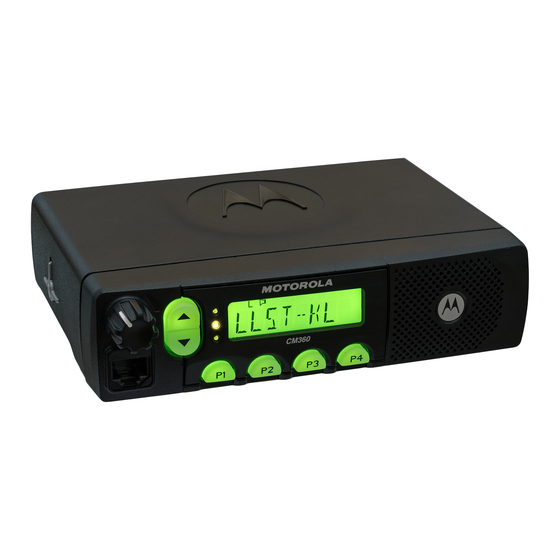Motorola CM340 Сервісна інформація - Сторінка 8
Переглянути онлайн або завантажити pdf Сервісна інформація для Радіо Motorola CM340. Motorola CM340 26 сторінок. Commercial series controlhead
Також для Motorola CM340: Посібник користувача (24 сторінок), Посібник користувача (5 сторінок), Посібник користувача (12 сторінок)

2-2
When the host radio needs to send date to the shift register, the radio asserts the shift register chip
select and the data is loaded to the shift register. For example, the host radio sends data to change
display channel or change LED status.
2.3
Keypad Keys
The control head keypad is a four-key design. All keys are configured as two analog lines read by
µP. The voltage on the analog lines varies between 0V and 3.3 V depending on which key is
pressed. If no key is pressed, the voltage at both lines is 3.3V. The key configuration can be thought
of as a matrix where the two lines represent one row and one column. Each line is connected to a
resistive divider powered by 3.3V. If a button is pressed, it will connect one specific resistor of each
divider line to ground level and thereby reduce the voltages on the analog lines. The voltages of the
lines are A/D converted inside the µP (ports PE 6 - 7) and specify the pressed button. To determine
which key is pressed, the voltage of both lines must be considered.
The same analog lines also support a keypad microphone. A microphone key press is processed in
the same manner like a control head key press.
2.4
Status LED's and Back Light Circuit
All indicator LEDs (red, yellow, and green) are driven by current sources. To change the LED status
the host radio sends a data message to the control head shift register via the SPI bus. The control
head shift register determines the LED status from the received data and switches the LEDs on or
off via Q5-Q7.
The back light for the keypad is always on. The back light current for the keypad is drawn from the
9.3 V source and controlled by two current sources. The LED current is determined by the resistor
at the emitter of the respective current source transistor.
2.5
Microphone Connector Signals
The MIC_PTT line (J802-3) is grounded when the PTT button on the microphone is pressed. When
released, this line is pulled to 9.3V by R805. Two transistor stages (Q802, Q801 and associated
parts) are used to level shift between 9.3V and 3.3V required for the uP while keeping the same
sense (active low for PTT pressed).
Two of the mic socket lines (J802-2,7) have dual functions depending on the type of microphone or
SCI lead connected. An electronic switch (U803) is used to switch these two lines between mic
keypad operation or SCI operation. The switch (mux) is controlled by the uP through J803-20 with
level shifting (and inversion) provided by transistor Q812. When MUX_CTRL (J803-20) is low the
electronic switch is in the mic keypad mode. The mic socket (J802) pin 2 is connected to the keypad
row line that goes to J803-13 and pin 7 is connected to the keypad column line that goes to J803-12.
When MUX_CTRL (J803-20) is high the electronic switch is in the SCI mode. The mic socket (J802
pin 2) is connected to the SCI line that goes to J803-4 and pin 7 is connected to the BOOT_RES line
that goes to J803-11.
The HOOK line (J802-6) is used to inform the uP which type of microphone or SCI lead is connected
to the microphone socket. The voltage of the HOOK line is monitored by the uP (port PE0,
MIC_SENSE) through a resistor divider on the main board. When the HOOK line is grounded (on
hook condition) or floating (2.8V nominal), the uP sets the mux (U803) for keypad operation to allow
the use of microphones with a keypad. When the HOOK line is connected to 9.3V, the uP sets the
mux for SCI operation. This mode is also used to select low cost mic operation where the gain of the
microphone path is increased (on the main board) to compensate for not having a pre-amp in the low
cost mic.
THEORY OF OPERATION
